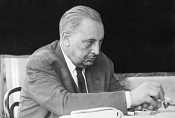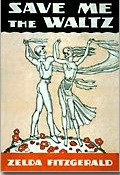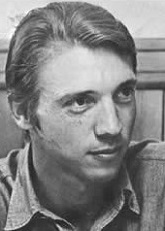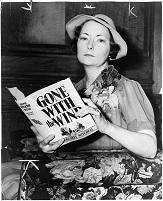Harper Lee and the Elusive Second Novel
The recent announcement of Harper Lee’s second novel—some 55 years after To Kill a Mockingbird—and subsequent controversy has set Library staff to talking about writers who have left their readers wanting, wondering, waiting, and wishing for that second novel.
The silence of a voice that once spoke so powerfully leaves us pondering what might have been, and wondering why the author didn’t publish another: Was it the pressures of early acclaim and fame? The disappointment of early commercial failure? Lack of inspiration? An early death? A late start to writing? As Lee's announcement recently made clear, there's a chance that we might still hear from the living authors below; but for some readers, the knowledge that there may be no potentially disappointing follow-up to lament can be a relief. After all, an unmarred body of work, even if it is one book, is a rare thing indeed.
Using the comments field below, please let us know your favorite one-novel wonder.
A few one-time novelists and their novels are as known as Lee and To Kill a Mockingbird: Margaret Mitchell (1900-1949) never published another novel after Gone with the Wind (1936), and Emily Bronte (1818-1848) died about a year after the publication of Wuthering Heights. Oscar Wilde (1854-1900) published what was probably the most famous novel of his time, The Picture of Dorian Gray (1891), due largely to the controversy it caused. Although he wrote prolifically, it is his only novel. It is debatable, but J.D. Salinger may have only one novel in his bibliography, Catcher in the Rye, if one considers Franny and Zooey a novella and a story. Ralph Ellison (1914-1994) famously published only one novel in his lifetime. Invisible Man won the National Book Award in 1953, but readers had to wait to wait for the posthumously-published Juneteenth in 1999 to read another novel by Ellison.
 Several other authors of a single novel, while not as well-known as those above, have built sizable followings over the years. Giuseppe Tomasi di Lampedusa (1896-1957) died at age 61 of lung cancer. A Sicilian aristocrat with a life-long love of literature, Tomasi wrote The Leopard during the last few years of his life and it shows the influence of the 19th century novelists that he admired. It was published posthumously and has since become a perennial favorite, well-read and still-loved, its fame helped no doubt by a 1963 film by Visconti. We can read other writings by Tomasi di Lampedusa—letters, criticism, a few short stories, and remembrances—but The Leopard is his only novel, and it is remarkable that he waited until age 57 or so to begin writing it.
Several other authors of a single novel, while not as well-known as those above, have built sizable followings over the years. Giuseppe Tomasi di Lampedusa (1896-1957) died at age 61 of lung cancer. A Sicilian aristocrat with a life-long love of literature, Tomasi wrote The Leopard during the last few years of his life and it shows the influence of the 19th century novelists that he admired. It was published posthumously and has since become a perennial favorite, well-read and still-loved, its fame helped no doubt by a 1963 film by Visconti. We can read other writings by Tomasi di Lampedusa—letters, criticism, a few short stories, and remembrances—but The Leopard is his only novel, and it is remarkable that he waited until age 57 or so to begin writing it.
Alain-Fournier (1886-1914)—real name, Henri Alban Fournier—published his only novel, Le Grand Meaulnes, in 1913. It has been translated into English several times with several titles including, The Lost Estate, The Wanderer, and The Lost Domain. Le Grand Meaulnes is a singular, dream-like exploration of adolescence, love, and memory (its implausible or just plain confusing twists do not detract from the experience of reading it). John Fowles called Le Grand Meaulnes a “masterpiece of alchemized memory” that “haunted him his whole life.” In his introduction to the latest translation, Adam Gopnik compares its place in the canon of French literature with The Catcher in the Rye in America’s, and in a recent poll of French readers it was rated sixth of all 20th-century books. The book has been praised by many writers, and acknowledged as an influence on authors from F. Scott Fitzgerald to David Mitchell. Among the testimonials of these luminaries, the word of this Library blogger certainly pales, but I will gladly take this opportunity to recommend reading it. Alain-Fournier died in Verdun during World War I, age 28.
The Middle Parts of Fortune (aka, Her Privates We) by Frederic Manning (1882-1935) has been called the finest war novel ever published. Its outspoken admirers include Ernest Hemingway (who claimed to re-read it annually), Arnold Bennett, and T.E. Lawrence. Frail, asthmatic, alcoholic, a published poet and critic, it is indeed strange that Frederic Manning enlisted to serve as a private in 1915 at the age of 33. His experiences on the Somme and Ancre fronts form the basis of his only novel, a blunt, realistic, and honest account of men in war. Originally published anonymously by Private 19022 in a small private edition in 1929 (the language was considered too coarse for wide distribution), The Middle Parts of Fortune is still in print today. Manning died largely unknown of pneumonia and asthma at age 53.
Some other notable examples include Richard Fariña’s 1966 counterculture cult classic, Been Down so Long it Looks Like Up to Me (Fariña died in a motorcycle accident at age 29, two days after  publication), and Save Me the Waltz (1932) by Zelda Fitzgerald (1900-1948). Jane Bowles, the wife of Paul Bowles, wrote one novel called Two Serious Ladies. Published in 1943, Tennessee Williams called it has favorite book. Currently back in print, Two Serious Ladies has developed a sizable cult following over the years. Patrick Leigh-Fermor (1915-2011) is an extremely popular writer here at the Society Library, known for his travel books, but his single novel, The Violins of Saint-Jacques: A Tale of the Antilles (1954), seems relatively obscure even to his legions of fans. The Stones of Summer (1972), by Dow Mossman (b. 1943) provides an exceptional example of the fascination a silent author can have upon a bewitched reader. Thirty years after publication, a filmmaker named Mark Moscovitz tracked the author down to find out why there were no other books. The resulting documentary, The Stone Reader, was released to wide acclaim in 2002. The authors of two of the most popular books of 1997, Arundhati Roy’s The God of Small Things and Arthur Golden’s Memoirs of a Geisha, have yet to follow up on the success of their first novels with another work of fiction. Eighteen years' wait is not in the same league as Harper Lee, and Roy has written extensively about politics, but millions of readers are probably wondering when they will be able to read a follow-up novel.
publication), and Save Me the Waltz (1932) by Zelda Fitzgerald (1900-1948). Jane Bowles, the wife of Paul Bowles, wrote one novel called Two Serious Ladies. Published in 1943, Tennessee Williams called it has favorite book. Currently back in print, Two Serious Ladies has developed a sizable cult following over the years. Patrick Leigh-Fermor (1915-2011) is an extremely popular writer here at the Society Library, known for his travel books, but his single novel, The Violins of Saint-Jacques: A Tale of the Antilles (1954), seems relatively obscure even to his legions of fans. The Stones of Summer (1972), by Dow Mossman (b. 1943) provides an exceptional example of the fascination a silent author can have upon a bewitched reader. Thirty years after publication, a filmmaker named Mark Moscovitz tracked the author down to find out why there were no other books. The resulting documentary, The Stone Reader, was released to wide acclaim in 2002. The authors of two of the most popular books of 1997, Arundhati Roy’s The God of Small Things and Arthur Golden’s Memoirs of a Geisha, have yet to follow up on the success of their first novels with another work of fiction. Eighteen years' wait is not in the same league as Harper Lee, and Roy has written extensively about politics, but millions of readers are probably wondering when they will be able to read a follow-up novel.
 Two works by one-time novelists that I consider underappreciated are Fat City (1970), by Leonard Gardner (b. 1933), and Waiting for Nothing (1935), by Tom Kromer (1906-1969). Set in Stockton, California with third-rate boxers at its center, it’s hard to imagine that a better novel than Fat City has been written about the sport—although to call it a “boxing novel” sells it short. The book was nominated for a National Book Award, and praised by Joan Didion, Walker Percy, and Denis Johnson, who wrote that he and other writers “talked about every paragraph of Fat City…the way couples sometimes reminisce about…falling in love.” After publication, Gardner wrote for television programs like NYPD Blue, published some short fiction in journals, and adapted Fat City into a screenplay (the very good film version was directed by John Huston), but no other novels have been published. Very little is known about Tom Kromer, and what is known is not terribly good: poverty, tuberculosis, and breakdowns color his brief biography. Kromer’s Waiting for Nothing is a tough piece of Depression-era social realism describing the rootless life of drifters and hobos during the Depression, a life Kromer lived for five years. There is no sentimentality or romanticizing in Kromer’s novel. Kindness is as scarce as money, and the drifters in these pages keep moving because they have no place to go. Waiting for Nothing was reviewed fairly widely, and was published in England with an admiring introduction by Theodore Dreiser. Still, it did not sell well, and Kromer’s physical and mental health deteriorated over the decades.
Two works by one-time novelists that I consider underappreciated are Fat City (1970), by Leonard Gardner (b. 1933), and Waiting for Nothing (1935), by Tom Kromer (1906-1969). Set in Stockton, California with third-rate boxers at its center, it’s hard to imagine that a better novel than Fat City has been written about the sport—although to call it a “boxing novel” sells it short. The book was nominated for a National Book Award, and praised by Joan Didion, Walker Percy, and Denis Johnson, who wrote that he and other writers “talked about every paragraph of Fat City…the way couples sometimes reminisce about…falling in love.” After publication, Gardner wrote for television programs like NYPD Blue, published some short fiction in journals, and adapted Fat City into a screenplay (the very good film version was directed by John Huston), but no other novels have been published. Very little is known about Tom Kromer, and what is known is not terribly good: poverty, tuberculosis, and breakdowns color his brief biography. Kromer’s Waiting for Nothing is a tough piece of Depression-era social realism describing the rootless life of drifters and hobos during the Depression, a life Kromer lived for five years. There is no sentimentality or romanticizing in Kromer’s novel. Kindness is as scarce as money, and the drifters in these pages keep moving because they have no place to go. Waiting for Nothing was reviewed fairly widely, and was published in England with an admiring introduction by Theodore Dreiser. Still, it did not sell well, and Kromer’s physical and mental health deteriorated over the decades.
Several famous poets have applied their craft to publishing a single novel. Some of these novels are well-known, such as The Bell Jar (1963), by Sylvia Plath (1932-1963), who died by suicide two weeks after its publication, Randall Jarrell’s (1914-1965) satire of academic life, Pictures from an Institution (1954), and Boris Pasternak’s (1890-1960) Doctor Zhivago (1957). The acclaimed southern poet, critic, and proponent of the agrarian movement, Allen Tate (1899-1979), published his only novel, The Fathers, in 1939, an excellent piece of Civil War fiction about families torn apart by conflicting loyalties. Galway Kinnell, who died on October 28, 2014, at 87, won both a Pulitzer and the National Book Award. He also wrote one little-known novel, called Black Light (1966). Perhaps the most surprising example is Walt Whitman (1819-1892) and his Franklin Evans, or, The Inebriate: a Tale of the Times, published in 1842. Few now seem to know this novel (I stumbled upon it in stack 6 one day), but it was Whitman’s most popular work during his lifetime, selling about 20,000 copies. It can be broadly described as a temperance / rags-to-riches tale set against antebellum New York City.


Disqus Comments